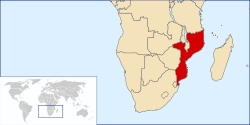People's Republic of Mozambique República Popular de Moçambique | |||||||||
|---|---|---|---|---|---|---|---|---|---|
| 1975–1990 | |||||||||
| Motto: "Unidade, Trabalho, Vigilância" ("Unity, Work, Vigilance") | |||||||||
| Anthem: "Viva, Viva a FRELIMO" (English: "Long Live, Long Live FRELIMO") (1975–2002)[note 1] | |||||||||
 | |||||||||
| Capital and largest city | Maputo[1] | ||||||||
| Official languages | Portuguese | ||||||||
| Religion | State atheism (de facto) Roman Catholicism, Islam | ||||||||
| Demonym(s) | Mozambican | ||||||||
| Government | Unitary Marxist–Leninist one-party socialist republic | ||||||||
| President | |||||||||
• 1975–1986 | Samora Machel | ||||||||
• 1986 | Political Bureau | ||||||||
• 1986–1990 | Joaquim Chissano | ||||||||
| Prime Minister | |||||||||
• 1986–1990 | Mário da Graça | ||||||||
| Legislature | People's Assembly | ||||||||
| Historical era | Cold War | ||||||||
| 8 September 1974 | |||||||||
• Independence from Portugal | 25 June 1975 | ||||||||
• Mozambican Civil War begins | 30 May 1977 | ||||||||
| 30 November 1990 | |||||||||
| Area | |||||||||
• Total | 801,590 km2 (309,500 sq mi) | ||||||||
• Water (%) | 2.2 | ||||||||
| HDI (1990) | 0.227 low | ||||||||
| Currency | Escudo (MZE) (1975–1980) Metical (MZM) (1980–1990) | ||||||||
| Drives on | left | ||||||||
| Calling code | +258 | ||||||||
| ISO 3166 code | MZ | ||||||||
| |||||||||
The People's Republic of Mozambique (Portuguese: República Popular de Moçambique) was a socialist state that existed in present-day Mozambique from 1975 to 1990. It was established when the country gained independence from Portugal in June 1975 and the Mozambican Liberation Front ("FRELIMO") established a one-party socialist state led by Samora Machel. The state enjoyed close political and military ties with the Soviet Union, which was one of the first nations to provide diplomatic recognition and financial support to the fledgling FRELIMO government.[3] For the duration of its history, the People's Republic of Mozambique remained heavily dependent on Soviet aid, both in financial terms as well as with regards to food security, fuel, and other vital economic necessities.[3] From 1977 to 1992, the country was devastated by a deadly civil war which pitted the armed forces against the anti-communist Mozambique National Resistance (RENAMO) insurgency, backed by neighbouring Rhodesia and South Africa.[4]
The People's Republic of Mozambique enjoyed close relations with the People's Republic of Angola, Cuba, and the German Democratic Republic (East Germany), which were socialist states at the time.[5][6] The People's Republic of Mozambique was also an observer of the COMECON ("Council for Mutual Economic Assistance"), which was an economic organization of socialist states.[7] Mozambique made a bid to formally join COMECON as a member state in the early 1980s but was rebuffed, despite East German sponsorship and endorsements.[3] Following the decline of Soviet and COMECON economic influence in the 1980s, the People's Republic of Mozambique sought rapprochement with the United States of America, the International Monetary Fund and the German Federal Republic after the death of Samora Machel and the beginning of economic reforms under Joaquim Chissano.
Geographically the People's Republic of Mozambique is the exact same as the present-day Republic of Mozambique, located on the southeast coast of Africa. It bordered Swaziland to the south, South Africa to the southwest, Rhodesia (later Zimbabwe) to the west, Zambia and Malawi to the northwest, and Tanzania to the north.
Cite error: There are <ref group=note> tags on this page, but the references will not show without a {{reflist|group=note}} template (see the help page).
- ^ known as Lourenço Marques until 1976
- ^ "The Constitution of the Republic of Mozambique, 1990" (PDF). World Bank. 2 November 1990. Retrieved 17 October 2020.
- ^ a b c Vanneman, Peter (1990). Soviet Strategy in Southern Africa: Gorbachev's Pragmatic Approach. Stanford: Hoover Institution Press. pp. 59–68. ISBN 978-0-8179-8902-6.
- ^ "Mozambique". Encarta. Archived from the original on 28 October 2009.
- ^ "Angola: Communist nations". February 1989.
- ^ de la Fosse Wiles, Peter John (1982). The New Communist Third World. Croom Helm. ISBN 978-0-7099-2709-9.
- ^ Burant, Stephen R. "Appendix B: The Council for Mutual Economic Assistance". East Germany: a country study (PDF). Washington, D.C.: Federal Research Division, Library of Congress. p. 300. LCCN 87600490.



